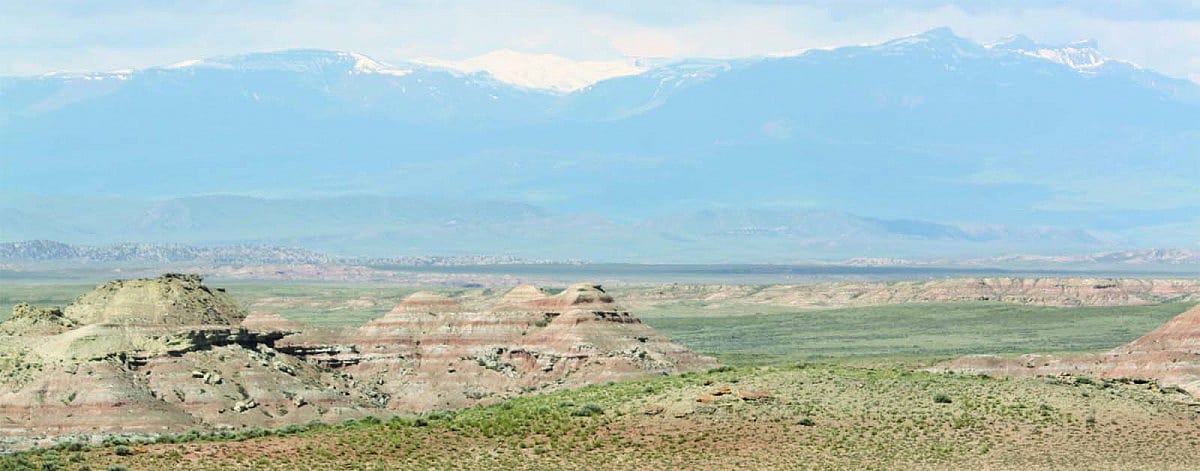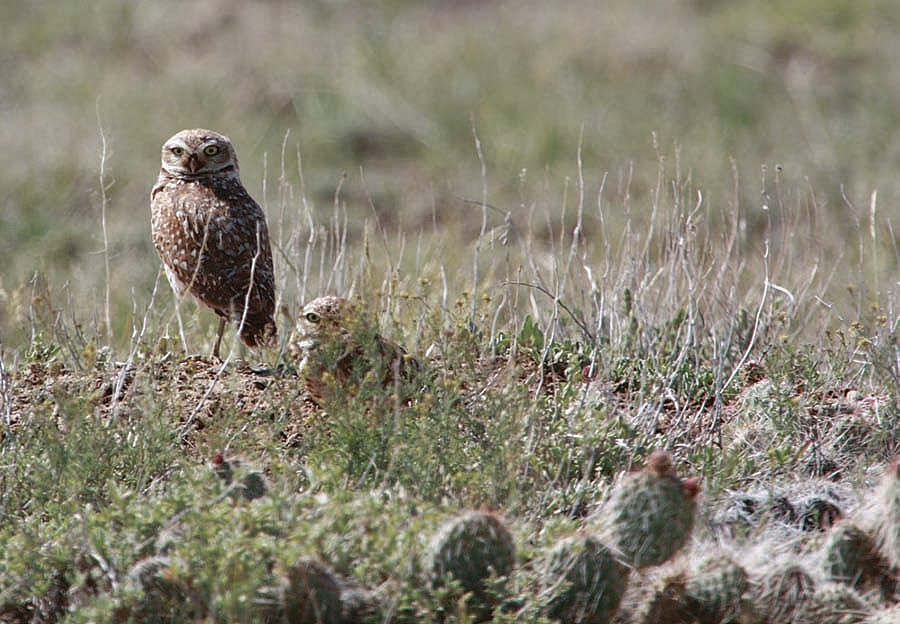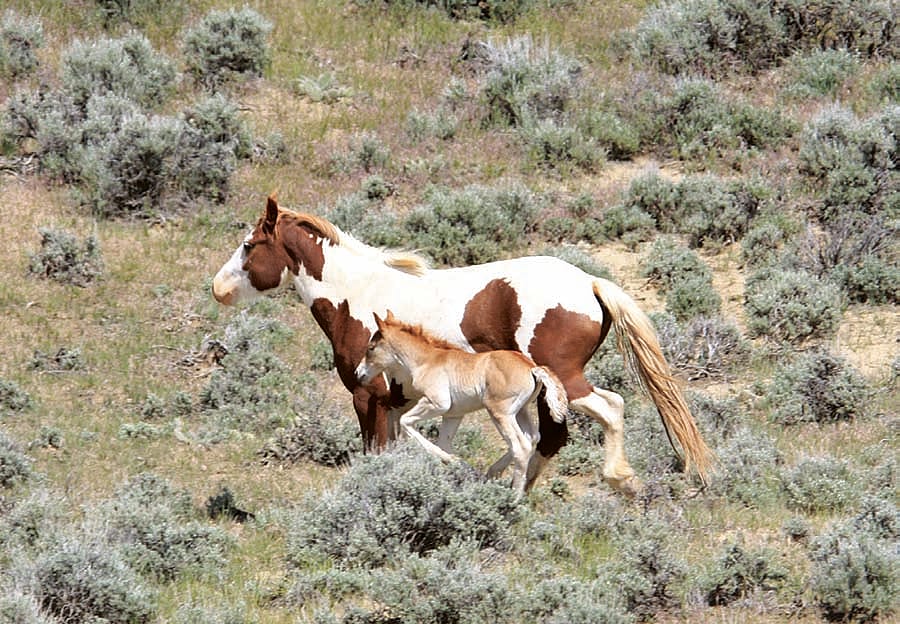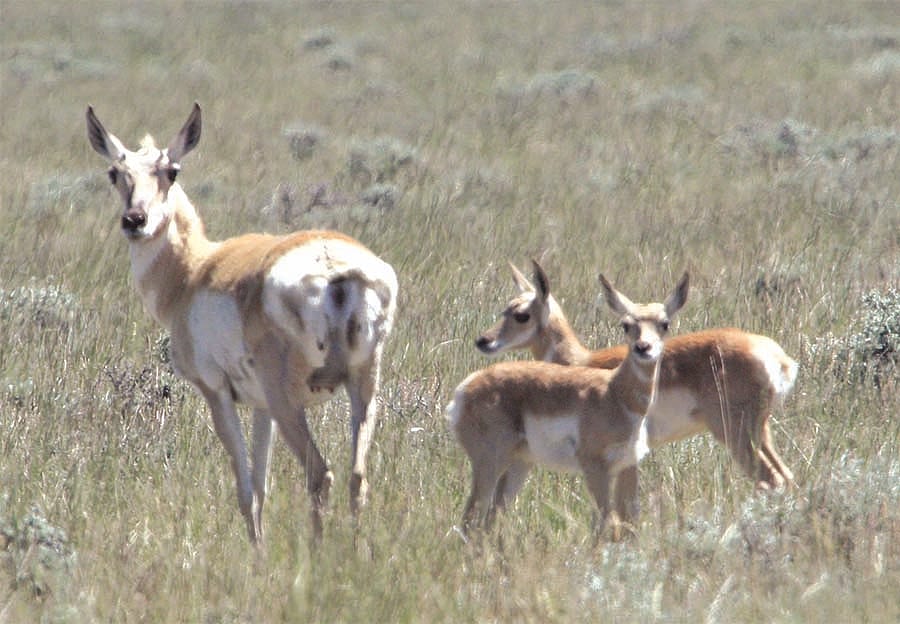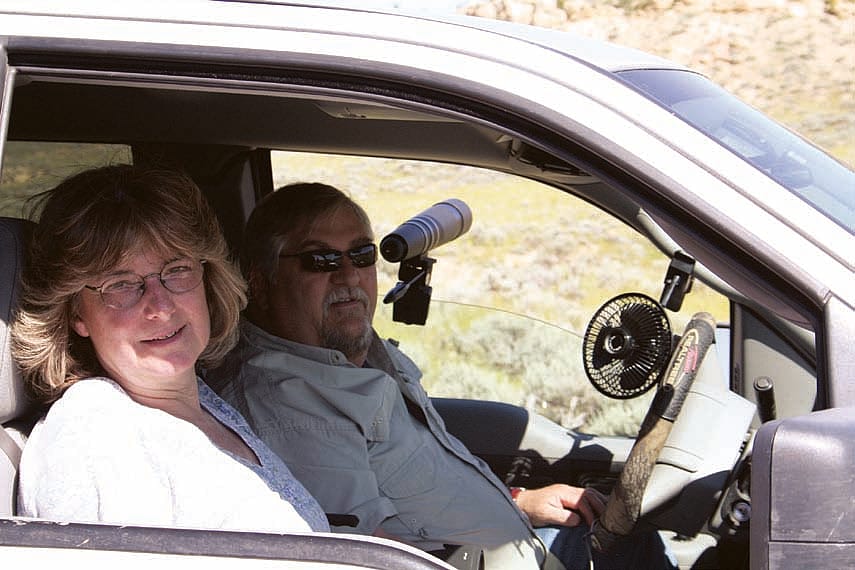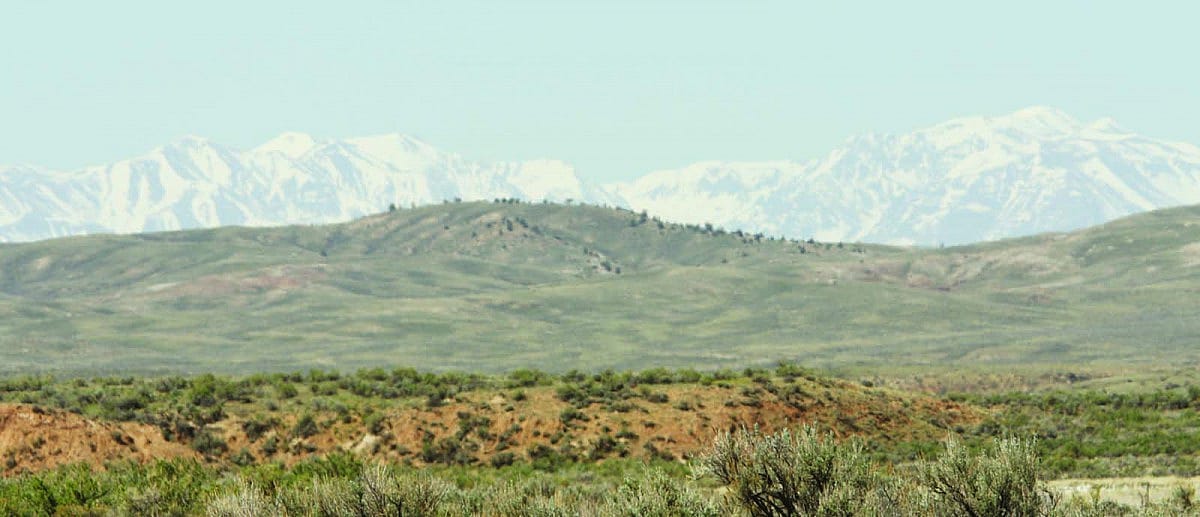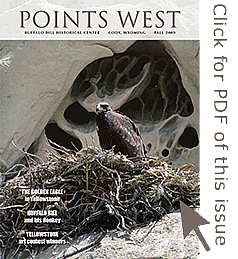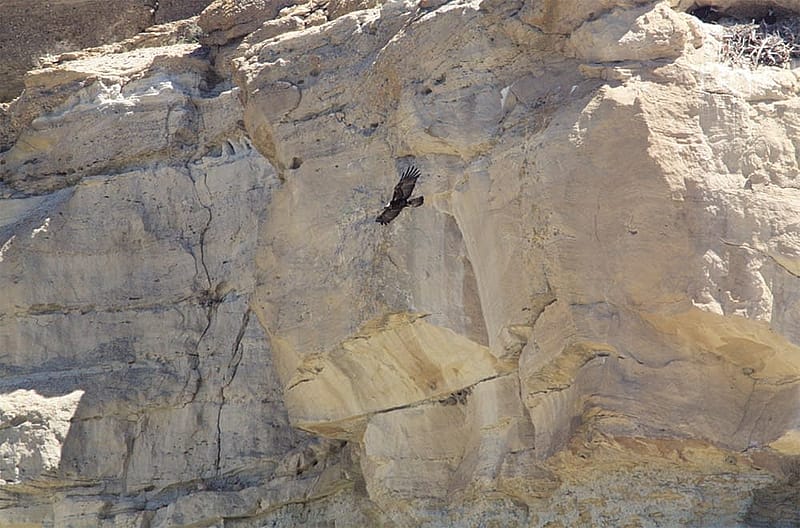
On the Trail of the Golden Eagle – Points West Online
Originally published in Points West magazine
Fall 2009
On the Trail of the Golden Eagle: Summer Fieldwork with the Golden Eagle Posse
By Charles R. Preston, PhD
Field of dreams…for researchers
Watch out — Rattlesnake! I could clearly hear the staccato rattling of the annoyed reptile as I crested the sandstone outcrop and looked out over the vast ocean of sagebrush, bunchgrasses, and wildflowers far below. Draper Museum research assistant Richard Jones had sounded the alarm and was pointing to a spot on the ground only about three feet from where he was standing. He had surprised the yard-long prairie rattlesnake as it basked in the early morning sun.
Before I could retrieve the camera from my backpack, the snake disappeared in the shadows under a rock ledge. “That’s only the fourth rattlesnake we’ve seen so far this season,” I said as I worked my way over to Richard and the third member of our party, Bureau of Land Management wildlife biologist Destin Harrell. It was early June, and the cool, wet weather of spring 2009 had put a damper on rattlesnake and other reptile activity in Wyoming’s Bighorn Basin. We could not remember when we’d seen the vegetation so lush and green in the basin in late spring.
Richard, Destin, and I had been hiking up to this rocky ledge for about thirty minutes so we could get into position to observe and photograph an active golden eagle nest without spooking the birds. This nest, identified on our data sheets as 3A, held two fluffy, down-covered eagle chicks and a doting parent less than one hundred meters from our position behind a broad limber pine tree. After watching the birds through spotting scopes for about thirty minutes, and making some notes in our field journals, we packed up and headed back down the rugged outcrop to the basin floor.
Our mission on this day was to verify the position and status of several of the more than thirty-five golden eagle nests that Richard had initially identified from his fixed-wing aerial survey flights in the weeks before. The surveys and on-the-ground fieldwork are key components of a five-year scientific study conducted by the Draper Museum of Natural History to better understand the complex relationships among climate, human land use, and wildlife in the sagebrush-steppe environment of the Bighorn Basin.
Field research is a hallmark and lifeblood of all great natural history museums, allowing us to involve the public in the excitement of new discoveries and to showcase both the product and process of exploration to the general public. Field research and exploration is to a museum what adrenaline is to a well-trained athlete: It provides the spark that drives us to achieve new heights as well as inspire interest and excitement in others.
Our current exploration is funded in part through grants by the Bureau of Land Management, among others, and focuses on the golden eagle as an umbrella species in the Bighorn Basin. A critical aspect of the research is the creation of a volunteer corps of “citizen-scientists” we refer to as our “Golden Eagle Posse.” This posse “rides the range” to keep tabs on golden eagle nests and returns with detailed information to help us piece together a complete ecological jigsaw puzzle of the Bighorn Basin, with people included as an integral piece of the puzzle.
The Bighorn Basin of Wyoming
The Bighorn Basin, located at the eastern edge of the Greater Yellowstone Ecosystem, includes approximately 4,000 square miles of sagebrush shrublands, mixed grasslands, deserts, and badlands. It epitomizes the landscapes that generally conjure up images of the American West in fine art, literature, movies, and television. Due to extensive residential sprawl and development in other western states, the Bighorn Basin supports one of the last large, virtually intact native sagebrush-steppe tracts left in the intermountain West.
Land ownership in the Bighorn Basin is divided among private and public hands, with the majority of public land administered by the Bureau of Land Management. Land use includes urban and exurban residential development, significant energy development, livestock grazing, and extensive motorized and non-motorized recreation. It is also an increasingly popular area for hunting and other outdoor recreation.
The basin’s golden resident
The golden eagle is an apex predator (i.e., not preyed on as healthy adults in the wild) in the Bighorn Basin. The species is present and commonly observed throughout the year, nesting on sandstone cliff faces and occasionally in large trees along riparian corridors or in irrigated fields. As one of North America’s largest and most charismatic predatory birds, the golden eagle always inspires special public interest. It is also especially responsive to environmental change. By virtue of their position at the top of the food chain, widespread occurrence, and relatively conspicuous nesting habits in the Bighorn Basin, golden eagles and other large raptors are excellent vehicles with which to explore the widespread effects of environmental change and human activity on wildlife in sagebrush-steppe ecosystems.
Although desert cottontail and white-tailed jackrabbit are presumably the most frequently occurring prey species in the golden eagle diet in the Bighorn Basin during breeding season, eagles also prey on the greater sage grouse. The impact of golden eagles on the grouse is of great interest. The latter is a species of special concern throughout its range and is a likely candidate for listing under the Endangered Species Act. If populations and distribution continue to decline, this is a real possibility. Because of its current status as a game species, the grouse carries significant economic importance in Wyoming.
The impact of eagles and other large raptors on sage grouse populations in the Bighorn Basin is unknown, but is expected to vary with habitat characteristics and availability of alternative prey. These factors may be affected, in turn, by human activities and climate change. Similarly, the impact of predation by golden eagles on livestock operations in the Bighorn Basin is unknown, but of interest to livestock producers and wildlife managers.
Here comes the posse
Our study is designed to determine the distribution, success, and productivity of golden eagle nests in selected areas of the Bighorn Basin as they relate to weather, habitat and landscape characteristics, and human activities. We also document the golden eagle diet during the nesting season and will explore other aspects of eagle biology—such as movements and population genetics—as the study progresses. We are able to identify and map active eagle nests with a combination of aerial and ground surveys early in the nesting season. We then follow up later in the year to see which nests have been successful in producing at least one chick and rearing it to independence and how many chicks each of these nests has produced.
We also collect prey remains where possible from around nest sites after the nests have been abandoned. When all these data are collected, we use Geographic Information Systems mapping to calculate and record more than twenty landscape and habitat characteristics surrounding each nest. Finally, we use a series of diverse statistical techniques to relate nesting success, productivity, and diet to landscape, habitat, and other factors measured.
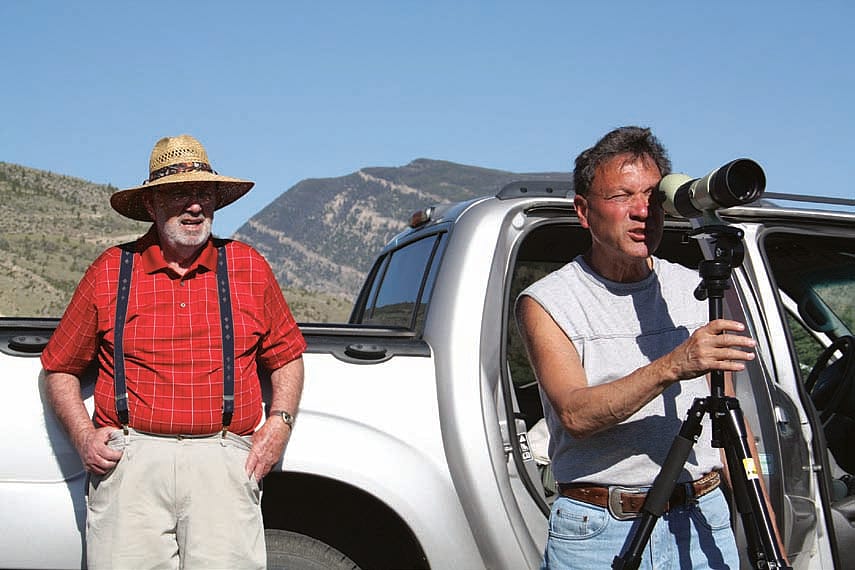
The posse to the rescue
Our Golden Eagle Posse of volunteer citizen-scientists helps with all aspects of the project, but the main task for posse members is to intensively monitor individual nests. In 2009, four two-person posse teams and one lone rider participated in the project. Each team “adopted” one nest to monitor for at least eight hours per week until the nest failed or chicks successfully fledged (left the nest independently).
Each team records eagle behavior at fifteen-minute intervals throughout the observation period and keeps a field journal with information about prey delivery and other action around their nest site. Here’s a sample of a recent note I received from one of our posse members, Rosemarie Hughes, when she visited a nest the day after her “adopted” chick successfully fledged:
When I drove around to the nest and our usual viewing spot, something was missing—our eaglet. It wasn’t there, and after canvassing the area, I didn’t see it anywhere. I did see, as I was driving to the nest, an eagle flying around the basin. At first, I thought it was the eaglet because its wings didn’t seem to be fully-developed, but after talking with you, it must have been a molting adult. I’ll tell you, I was very disappointed when I didn’t see our chick there; it was a very sad time for me.
After talking with you, I did make my way up to the nest. As I was just at the level of the lower nest (or the twigs that had been pushed out of the nest), I heard something that scared the holy bajebees out of me: It was the eaglet! I didn’t see it, but it must have seen me and didn’t like what it saw, so it took off. That was a good thing in a way; at least it could fly. I went over to where it was and saw what looked like part of a cottontail. I just left it and walked a little more over to the east, and there were some other bits and pieces, which I left there also. Since it appeared that it was eating off the bunny, I didn’t want to take its food source. It was a sad day, but a happy day too, because I did actually see the eaglet fly away—a success!”
What’s next
Collecting and recording observations like this is a great learning and recreational experience for posse members and builds a treasure trove of information for science. A corps of well-trained volunteers can contribute an enormous amount of new information to studies like this one, and many of their observations will find their way into scientific journals. Some organizations, such as EarthWatch Institute, even help fund museum and university programs that include volunteers in field research.
This year, every one of our monitored nests was successful, and the pilot project has been so successful that we plan to expand the posse to at least ten teams in 2010. We also plan to create some exciting hands-on learning experiences in the field for youth, family, and student groups beginning next year.
We are still gathering data as I write this article, so we won’t have the results of our analyses for several weeks. In general, however, we have discovered that our study area contains a much higher density of nesting golden eagles than expected: It could be one of the highest concentrations of nesting golden eagles in North America. We have also confirmed that rabbits dominate the diet of golden eagles in the Bighorn Basin, followed by ground squirrels and other rodents, and snakes. In the future, we will be able to determine how yearly variations in weather, prey availability, and other factors influence golden eagle nesting occurrence, distribution, success, and diet, and how apex predators like eagles influence other species and the environment that supports them.
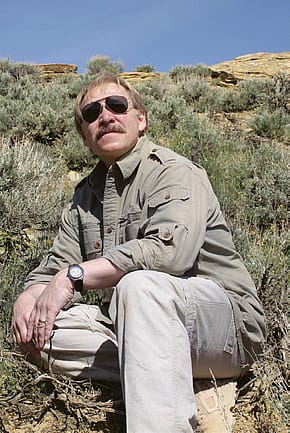
Yes, we’re already looking forward to next year’s field season. We will attempt to place remote cameras at some nest sites to record behavior and food delivery every hour of the day for our Greater Yellowstone Sights and Sounds Archive and explore opportunities to feed live video from the field to our exhibit galleries and Web site. We also plan to install a small, interactive kiosk in the Draper Museum to keep our visitors updated on annual fieldwork and discoveries. Finally, we will post weekly field note blogs on our Web site during next summer’s fieldwork. So stay tuned as we continue to bring the “nature of the West” to you and all of our audiences through a variety of traditional and innovative vehicles!
About the author
Dr. Charles R. Preston is Founding Curator of the Draper Museum of Natural History. He was previously Zoology Department Chair at the Denver Museum of Natural History, and before that, Associate Professor of Biological Sciences at the University of Arkansas at Little Rock. He holds or has held adjunct faculty appointments in biology and environmental science at the University of Colorado (Boulder and Denver campuses), environmental policy and management at the University of Denver, and biological sciences at the University of Arkansas, Fayetteville.
A zoologist and wildlife ecologist by training, Preston currently focuses on human dimensions of wildlife management and conservation in North America, especially the Greater Yellowstone region and the American West. Much of his field research concentrates on raptors and predator-prey dynamics in changing environments. A strong advocate for the role of scientists as public educators, he is interested in the evolving role of informal science education in society. A prolific writer, Preston has authored four books and more than sixty scholarly and popular articles.
Post 244
Written By
Nancy McClure
Nancy now does Grants & Foundations Relations for the Center of the West's Development Department, but was formerly the Content Producer for the Center's Public Relations Department, where her work included writing and updating website content, publicizing events, copy editing, working with images, and producing the e-newsletter Western Wire. Her current job is seeking and applying for funding from government grants and private foundations. In her spare time, Nancy enjoys photography, reading, flower gardening, and playing the flute.
